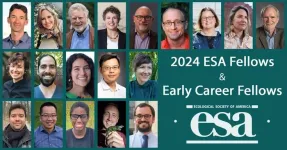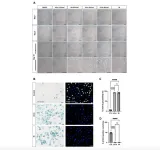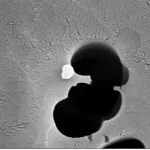(Press-News.org) Researchers from Carnegie Mellon University and University of Pennsylvania published a new Journal of Marketing study that examines online educational platforms and the question of whether they should release content through a scheduled format that resembles a traditional university course or use an on-demand release strategy.
The study, forthcoming in Journal of Marketing, is titled “More Likely to Pay but Less Engaged: The Effects of Switching Online Courses from Scheduled to On-Demand Release on User Behavior” and is authored by Joy Lu, Eric T. Bradlow, and J. Wesley Hutchinson.
In 2011, the online education industry catered to around 300,000 consumers. In 2021, it served 220 million, thanks in part to increased enrollment during the COVID-19 pandemic. Traditional universities and institutions are increasingly adopting hybrid course formats. For example, the number of full-time online MBA students surpassed in-person MBA students for the first time in the 2020-21 academic year.
Today, online educational platforms like Coursera and edX offer a range of flexible course content, but these firms are faced with a tricky question: Should they release content through a scheduled format that resembles a traditional university course with a subset of lectures and quizzes available at the start of each week, or should they follow in the footsteps of Netflix and Hulu with an on-demand release strategy where all the material is immediately available upon registration?
This new Journal of Marketing article finds that the choice of format for content release not only impacts overall user engagement and firm revenue but also user performance and learning outcomes.
The researchers studied over 67,000 users taking an introductory marketing course on Coursera consisting of 32 short lecture videos and 4 quizzes. The study took advantage of a natural experiment policy change where the platform switched the course from a scheduled format to an on-demand release format while keeping the actual content the same.
The scheduled format closely resembled a traditional university course, with some of the study material available at the beginning of each week for four weeks. In the on-demand format, all four weeks of content was made available upon registration. All users could take the course for free or opt into paying for a completion certificate, either as a one-time fee in the scheduled format or a monthly subscription in the on-demand format.
More Users, Less Engagement
The study’s findings show that the switch to on-demand content doubled the percentage of paying users from 14% to 28%. Lu explains that “the on-demand format was successful in increasing short-term firm revenue by bringing in more paying users. On the downside, the switch resulted in significantly lower lecture completion rates and lower quiz performance.”
The on-demand format also negatively impacted downstream platform engagement. The marketing course was promoted in a “Business Foundations” set with three other courses on operations, accounting, and finance. “Compared to users in the scheduled format, those in the on-demand format ended up taking one or two fewer additional courses six months after the focal marketing course,” says Bradlow.
Analysis of user activity reveals two new learning patterns:
A subset (13%) of users in the on-demand format continued to return and take quizzes well beyond the recommended four-week course period. The greater flexibility in the on-demand content release and payment structure likely enabled these users to “stretch out” their consumption.
The on-demand format increased the practice of binging – with user activity being clumped together (i.e., more binging) as compared to being evenly spaced out (i.e., less binging). In the scheduled format, binging was negatively related to course performance, which is consistent with the intuition that binging reflects procrastination or cramming. However, in the on-demand format, binging was positively related to performance, suggesting that on-demand users may binge as a form of strategic time management by setting aside time to consume in spurts.
Real-World Implications
This study offers vital lessons for chief marketing officers in the online education space:
The switch to the on-demand format attracted a set of users who were more likely to pay, but were less engaged in the course. On-demand content is potentially helpful at bringing in a new user segment or expanding the current user base, similar to universities offering concurrent hybrid MBAs that cater to busy students with full-time jobs. Managers must consider the trade-off between offering structure versus flexibility and may even consider offering different content release options simultaneously but at different price points by emphasizing their unique features.
Platforms may need to adapt their content to account for users who binge on content and others who space it out over time. For example, firms can include more recaps or reviews to reduce frustration resulting from users forgetting content. It may even be a viable strategy to embrace the prevalence of binging among users by highlighting or designing sets of lectures that are “bingeable” versus more modular.
Many online platforms offer episodic content that may be released in installments and thus need to make decisions regarding the content release format. “Our study provides insights that help managers anticipate the potential consequences of such decisions,” says Hutchinson. “On-demand content offers clear short-term benefits in terms of increased revenue but potentially long-term costs in terms of decreased engagement and new challenges in maintaining user engagement.”
Full article and author contact information available at: https://doi.org/10.1177/00222429241227145
About the Journal of Marketing
The Journal of Marketing develops and disseminates knowledge about real-world marketing questions useful to scholars, educators, managers, policy makers, consumers, and other societal stakeholders around the world. Published by the American Marketing Association since its founding in 1936, JM has played a significant role in shaping the content and boundaries of the marketing discipline. Shrihari (Hari) Sridhar (Joe Foster ’56 Chair in Business Leadership, Professor of Marketing at Mays Business School, Texas A&M University) serves as the current Editor in Chief.
https://www.ama.org/jm
About the American Marketing Association (AMA)
As the largest chapter-based marketing association in the world, the AMA is trusted by marketing and sales professionals to help them discover what is coming next in the industry. The AMA has a community of local chapters in more than 70 cities and 350 college campuses throughout North America. The AMA is home to award-winning content, PCM® professional certification, premiere academic journals, and industry-leading training events and conferences.
https://www.ama.org
END
The question for online educational platforms: offer courses following a schedule or release them on demand?
News from the Journal of Marketing
2024-04-30
ELSE PRESS RELEASES FROM THIS DATE:
Study: racial bias is no 'false alarm' in policing
2024-04-30
Black drivers are more frequently searched during traffic stops without finding contraband than white drivers, according to a University of Michigan study.
Institute for Social Research scientists Maggie Meyer and Richard Gonzalez analyzed data from 98 million traffic stops, and showed that innocent Black drivers were likely to be searched about 3.4 to 4.5 percent of the time while innocent white drivers were likely to be searched about 1.9 to 2.7 percent of the time. Their results are published in the Journal of Quantitative Criminology.
"We show that there's ...
Ecological Society of America announces 2024 Fellows
2024-04-30
The Ecological Society of America is pleased to announce its 2024 Fellows. The Society’s fellowship program recognizes the many ways in which its members contribute to ecological research, communication, education, management and policy. This year, the ESA Governing Board has confirmed nine new Fellows and ten new Early Career Fellows.
Fellows are members who have made outstanding contributions to a wide range of fields served by ESA, including, but not restricted to, those that advance or apply ecological knowledge in academics, ...
Mass General Brigham researchers identify potential drivers of chronic allergic inflammation
2024-04-30
Currently, most therapies for allergic diseases require lifelong treatment. Allergic reactions, characterized by ongoing (type 2) inflammation in response to chronic antigen exposure, underlie many chronic diseases in humans, including asthma, atopic dermatitis, ulcerative colitis and more. T helper 2 (Th2) cells play an important role in the body's immune response, particularly in allergic reactions. Despite their central role, the sustained activity of Th2 cells during allergic reactions, even in the face of constant antigen exposure, has long puzzled researchers.
A research team that included authors from Mass General Brigham, including ...
Scientists solve chemical mystery at the interface of biology and technology
2024-04-30
Link to release:
https://www.washington.edu/news/2024/04/30/oects/
Researchers who want to bridge the divide between biology and technology spend a lot of time thinking about translating between the two different “languages” of those realms.
“Our digital technology operates through a series of electronic on-off switches that control the flow of current and voltage,” said Rajiv Giridharagopal, a research scientist at the University of Washington. “But our bodies operate on chemistry. In our brains, neurons ...
Shaping the Future of Neuroendocrine Tumor Management
2024-04-30
MIAMI, FLORIDA (April 30, 2024) – Newly updated guidelines on neuroendocrine tumors developed by an expert at Sylvester Comprehensive Cancer Center at the University of Miami Miller School of Medicine and collaborators provide clinicians with the latest recommendations for staging and management of these rare but increasingly diagnosed tumors.
The guidelines, developed for the American Joint Committee on Cancer (AJCC) and summarized today in CA: A Cancer Journal for Clinicians, highlight recent changes for treating these tumors and offer a snapshot of this rapidly evolving ...
Scientists show ancient village adapted to drought, rising seas
2024-04-30
Around 6,200 BCE, the climate changed. Global temperatures dropped, sea levels rose and the southern Levant, including modern-day Israel, the Palestinian territories, Jordan, Lebanon, southern Syria and the Sinai desert, entered a period of drought.
Previously, archaeologists believed that this abrupt shift in global climate, called the 8.2ka event, may have led to the widespread abandonment of coastal settlements in the southern Levant. In a recent study published with the journal Antiquity, researchers at UC San Diego, the University of Haifa and Bar-Ilan University share new evidence suggesting at least one village formerly thought abandoned not only remained occupied, but ...
Cover paper: Senescent characteristics of human corneal endothelial cells upon UV-A exposure
2024-04-30
“[...] these findings may help to advance our understanding of the pathogenesis of corneal endothelial disease and may lead to the discovery of new therapies targeting senescent cells.”
BUFFALO, NY- April 30, 2024 – A new research paper was published on the cover of Aging (listed by MEDLINE/PubMed as "Aging (Albany NY)" and "Aging-US" by Web of Science) Volume 16, Issue 8, entitled, “Senescent characteristics of human corneal endothelial cells upon ultraviolet-A exposure.”
In ...
Activity in a room stirs up nanoparticles left over from consumer sprays
2024-04-30
Common household products containing nanoparticles – grains of engineered material so miniscule they are invisible to the eye – could be contributing to a new form of indoor air pollution, according to a Rutgers study.
In a study published in the journal Science of the Total Environment, a team of Rutgers researchers found people walking through a space, where a consumer product containing nanoparticles was recently sprayed, stirred residual specks off carpet fibers and floor surfaces, projecting them some three ...
NASA’s Webb maps weather on planet 280 light-years away
2024-04-30
An international team of researchers has successfully used NASA’s James Webb Space Telescope to map the weather on the hot gas-giant exoplanet WASP-43 b.
Precise brightness measurements over a broad spectrum of mid-infrared light, combined with 3D climate models and previous observations from other telescopes, suggest the presence of thick, high clouds covering the nightside, clear skies on the dayside, and equatorial winds upwards of 5,000 miles per hour mixing atmospheric gases around the planet.
The investigation is just the latest demonstration of the exoplanet science now possible with Webb’s ...
Webb captures top of iconic horsehead nebula in unprecedented detail
2024-04-30
NASA’s James Webb Space Telescope has captured the sharpest infrared images to date of a zoomed-in portion of one of the most distinctive objects in our skies, the Horsehead Nebula. These observations show the top of the “horse’s mane” or edge of this iconic nebula in a whole new light, capturing the region’s complexity with unprecedented spatial resolution.
Webb’s new images show part of the sky in the constellation Orion (The Hunter), in the western side of a dense region known as the Orion B molecular cloud. Rising from turbulent waves of dust and gas is the Horsehead Nebula, otherwise known as ...
LAST 30 PRESS RELEASES:
Numbers in our sights affect how we perceive space
SIMJ announces global collaborative book project in commemoration of its 75th anniversary
Air pollution exposure and birth weight
Obstructive sleep apnea risk and mental health conditions among older adults
How talking slows eye movements behind the wheel
The Ceramic Society of Japan’s Oxoate Ceramics Research Association launches new international book project
Heart-brain connection: international study reveals the role of the vagus nerve in keeping the heart young
Researchers identify Rb1 as a predictive biomarker for a new therapeutic strategy in some breast cancers
Survey reveals ethical gaps slowing AI adoption in pediatric surgery
Stimulant ADHD medications work differently than thought
AI overestimates how smart people are, according to HSE economists
HSE researchers create genome-wide map of quadruplexes
Scientists boost cell "powerhouses" to burn more calories
Automatic label checking: The missing step in making reliable medical AI
Low daily alcohol intake linked to 50% heightened mouth cancer risk in India
American Meteorological Society announces Rick Spinrad as 2026 President-Elect
Biomass-based carbon capture spotlighted in newly released global climate webinar recording
Illuminating invisible nano pollutants: advanced bioimaging tracks the full journey of emerging nanoscale contaminants in living systems
How does age affect recovery from spinal cord injury?
Novel AI tool offers prognosis for patients with head and neck cancer
Fathers’ microplastic exposure tied to their children’s metabolic problems
Research validates laboratory model for studying high-grade serous ovarian cancer
SIR 2026 delivers transformative breakthroughs in minimally invasive medicine to improve patient care
Stem Cell Reports most downloaded papers of 2025 highlight the breadth and impact of stem cell research
Oxford-led study estimates NHS spends around 3% of its primary and secondary care budget on the health impacts of heat and cold in England
A researcher’s long quest leads to a smart composite breakthrough
Urban wild bees act as “microbial sensors” of city health.
New study finds where you live affects recovery after a hip fracture
Forecasting the impact of fully automated vehicle adoption on US road traffic injuries
Alcohol-related hospitalizations from 2016 to 2022
[Press-News.org] The question for online educational platforms: offer courses following a schedule or release them on demand?News from the Journal of Marketing





